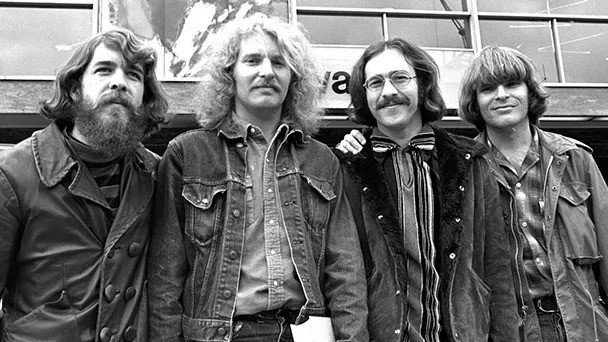Few musical ensembles encapsulate the rebellious spirit of counterculture quite like Creedence Clearwater Revival. Their music, epitomized by anthems like ‘Proud Mary’ and the trenchant anti-Vietnam ballad ‘Fortunate Son’, not only resonated deeply with the progressive sentiments of their generation but also continues to be celebrated fervently in contemporary times.
Ironically, the band’s journey began under a name that now evokes discomfort and criticism: The Golliwogs. Originating from the popular rag doll character inspired by Florence Kate Upton’s illustrations, the name carries connotations of racial caricature. This contradiction between their progressive ethos and their former moniker remains a perplexing footnote in the annals of popular music history.
The genesis of CCR, and its precursor The Golliwogs, can be traced back to their formative years at Portola Junior High in El Cerrito, California, during the vibrant 1950s. It was here that John Fogerty, Doug Clifford, and Stu Cook first crossed paths and eventually formed a musical alliance. Initially known as The Blue Velvets, the trio honed their craft playing instrumental pieces and popular jukebox standards, often supporting John’s older brother Tom in recording sessions and live performances. Their chemistry was undeniable, prompting Tom to join the band full-time in 1961, leading to the release of six singles between October 1961 and June 1962.
In 1964, the band inked a deal with the San Francisco-based independent jazz label Fantasy Records, known for its association with luminaries like Dave Brubeck and Lenny Bruce. It was here that The Blue Velvets underwent a controversial name change to The Golliwogs, orchestrated by label co-owner Max Weiss. This period also witnessed a pivotal lineup reshuffle, with Tom Fogerty assuming rhythm guitar duties, John Fogerty stepping into the role of vocalist and primary songwriter, and Stu Cook transitioning to bass guitar. This transformation laid the groundwork for the artistic brilliance that would define Creedence Clearwater Revival.
The tumultuous backdrop of the Vietnam War significantly influenced the band’s trajectory. Both John Fogerty and Doug Clifford were drafted into the US Armed Forces in 1966, though they managed to avoid combat duty. Fogerty’s military service, marked by his disdain for the war, would later inspire some of CCR’s most poignant compositions, including ‘Fortunate Son’ and ‘Proud Mary’. Notably, ‘Proud Mary’ was penned the moment Fogerty received his discharge papers.
During this period, Fogerty’s influence within the group burgeoned. He not only served as the band’s frontman and chief songwriter but also assumed the role of producer by 1967. With the pieces falling into place, CCR was poised for mainstream success, albeit burdened by its contentious name.
Fortune smiled upon the band once again in 1967 when movie producer Saul Zaentz acquired Fantasy Records. Zaentz, disapproving of the name The Golliwogs, extended an invitation for the band to record an album under a new moniker. In January 1968, they christened themselves Creedence Clearwater Revival, a name derived from disparate sources, reflecting their desire for a distinctive identity.
The year 1968 marked a transformative phase for Creedence Clearwater Revival as they transitioned from their Golliwogs past to become one of the most influential acts of their era. Buoyed by the success of their cover of ‘Susie Q’ receiving extensive airplay on local radio stations, the band released their self-titled debut album later that year.
However, it was 1969 that proved to be their watershed moment, with the release of three critically acclaimed albums within 12 months, solidifying their place in music history. Yet, tensions between the band and Fantasy Records would soon cast a shadow over their meteoric rise.
